Big Red Book
Celebrating television's This Is Your Life
Behind The Scenes
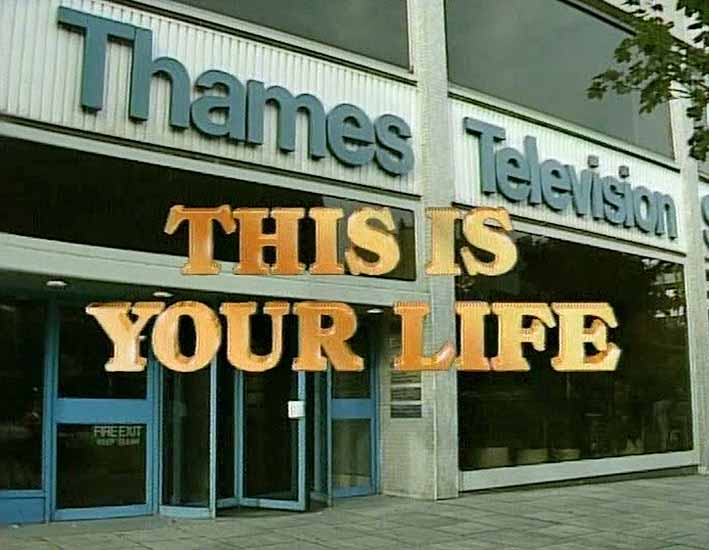
Roy Bottomley, former national newspaper journalist, television news editor, producer and writer of television comedy, drama and documentaries, was involved in every This Is Your Life edition from when the series began broadcasting on ITV in 1969 until 1995.
In his book This Is Your Life: The Story of Television's Famous Big Red Book, published in 1993, he revealed what went on behind the scenes in the top-secret planning office of Britain's most popular factual television series in the lead-up to the moment when the four most famous words on television were uttered...
related pages...
a brief biography
a career review
the programme's icon
the producers who steered the programme's success
the iconic titles and theme tunes
the studio look and locations
the applause, laughter and tears
the show's fifty year history
those who said 'No'
How is someone chosen to be the guest of honour on This Is Your Life? And what goes on between then and the moment Michael Aspel surprises that person with the Big Red Book and the four most famous words on British television?
The answers to those questions, and many more, are behind the closed doors of Room 226 at Teddington Studios, riverside headquarters of Thames TV. All the secrets of This Is Your Life are here, in this green-carpeted, open-plan office. This is the programme's nerve centre, though it is no place for the nervous; too many things can go wrong between a name being chosen and that person walking on to the familiar set to the signature tune of Gala Performance (specially arranged for Life by Carl Davis) and thunderous applause.
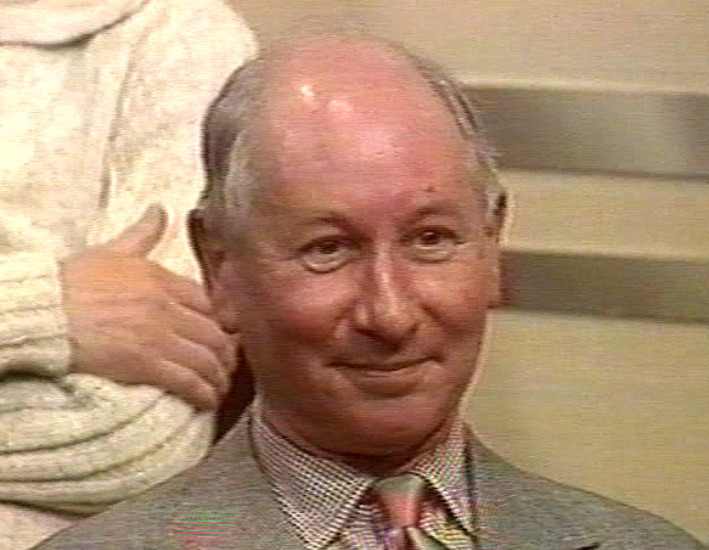
Writer Richard Gordon, the author of the 'Doctor' books, initially refused the Big Red Book in February 1974
Two particular examples of what can go wrong are never far from the Life team's memories – soccer star Danny Blanchflower taking one look at the book and doing a runner, and Richard Gordon, author of the 'Doctor' books, blurting out 'Oh balls!' live in front of millions of viewers. He fled the studio, but was persuaded to return and the programme was transmitted the following week.
And no one in Room 226 answers the telephone with the words 'This Is Your Life office'. Comedy actor Ronnie Barker had become suspicious about his wife taking mysterious telephone calls. When he came across a piece of paper with a telephone number and the name Brian written on it, he decided to ring the number. 'This Is Your Life office,' answered the researcher, and the show was lost. Now the standard reply is simply: 'Can I help you?'
Happier memories for the Life's researchers are stuck to walls, desks, noticeboards and typewriters. These are replicas of the gilt-on-red-leather names that are revealed on the front of the Big Red Book. There they are, all part and parcel of Life's history: Earl Mountbatten of Burma, Omar Sharif, Joan Collins, Falklands hero Simon Weston, The Bee Gees, Phil Collins, Barbara Cartland and many more.
Also on the office walls are photographs recalling the team's visits to make programmes in Hollywood and New York, and postcards from globetrotting researchers from all over the world.
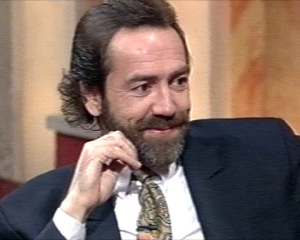
The actor Robert Lindsay was surprised on stage at London's Theatre Royal, Haymarket, in March 1992
Stuck to the inside of the office door is a note from award-winning actor Robert Lindsay: 'Dear All, thank you for a most thrilling night. I hope to pay you all back in some way, as horrible as I can think of. Love, Bob.' And with that note came a bottle of champagne for every member of the team.
When you open that office door this is what you see: a large square table around which the team gathers for production meetings and script conferences with Michael Aspel, much enlivened by his natural charm and wit (often mildly risqué and all the funnier for it).
My little office is in the corner of the big room. Here I compose the contents of Michael's Big Red Book on my ancient portable typewriter. This happens, of course, after the researchers have delivered several tons of paperwork with the background to our subjects, likely contributions and surprises. My first task is to sift through all the available material, including any books on or by the subject. Then I draw up what in my view is the best possible running order. In television terms it is often best not to tell a story in strict chronological order, and for This Is Your Life I like to sprinkle the surprises over our twenty-five minutes and five seconds of running time.
That is my capacity as scriptwriter. I am also programme consultant, and as such am one of the triumvirate – the others being producer Malcolm Morris and associate producer John Graham – which largely decides the names that will appear on the Big Red Book. This involves suggesting likely candidates and keeping a close eye on early research, looking out for any likely pitfalls or blind alleys we might find ourselves going down if we're not wary.
In the main office, nearest to the big table, is the desk of programme co-ordinator Mandy Lee. Her demanding job is to make sure everybody appearing on the programme reaches the studio and gets back home again. Often there are scores of people on one programme. And some of the most moving reunions have involved travel from remote corners of the world. Little wonder Mandy sometimes looks as though she has a telephone sprouting from each ear.
Passing her desk, a snatch of one of her urgent telephone calls might be: 'So, she's no longer in Cambodia? She's now where? Moscow. And she hasn't got a visa...' A roll of Mandy's eyes.
Looking down the length of the office from Mandy's desk, you see a centre aisle flanked by the desks of the five researchers. Rarely are all of them in the office at the same time. From Manchester to Miami, Newcastle to New York, they are on the trail of the programme's surprises: those offstage voices which will bring a whoop of recognition from the guest of honour, or an expression of frustrated concentration as the memory seeks to put a face to the voice.
At the occupied desks, researchers are never off the phone, making calls or fielding them. The fax machine has steam coming from it.
Fragments of telephone conversations you might overhear as you walk past the desks:
'We could get a film crew to the President no matter where he's going to be...'
At another phone: 'Not seen each other for forty years?' A pause. The researcher listens. 'Until last week...' Elation deflates.
To the left: 'Mr O'Toole will join us live? Wonderful.' A thumbs-up signal.
To the right: 'Ideally we would like permission to have the princess in shot...'
Film researcher Sue Tiplady's is the last of the researcher's desks. It is her job to locate and get clearance for use of all those fascinating film inserts you see on This Is Your Life, from Hollywood spectaculars to long-lost home movies. Included in her many film-world contacts are amateur movie buffs and collectors, some with priceless footage.
To Sue's right sits the production secretary, Avril Norton. One of her jobs is to make sure every one of the viewers' letters (and there are dozens a day) is attended to. Some propose people the viewer believes might be worthy of a Life tribute; others may request either a repeat of last week's programme, or a cassette, because they were out and missed it...
One of the more bizarre letters came from a man seen in drag on one of our film inserts. He thought a fee of £100 might cover his embarrassment.
We are almost at the end of the lengthy office. The last desk is that of associate producer John Graham. Though only in his late thirties, John is a Life veteran. Himself a former researcher, he knows at first hand every problem that can get in the way of delivering a successful programme. He and Michael Aspel go back a long way. When Michael was a Capital Radio DJ in the mid-1970s, John was the traffic reporter.
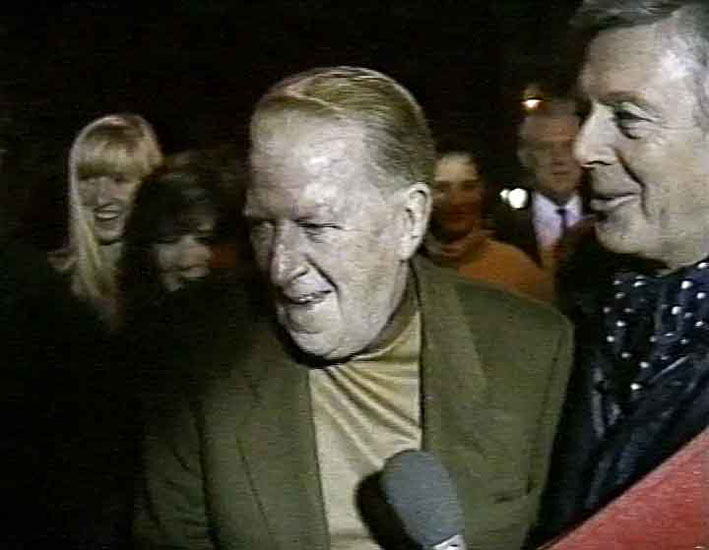
Bernard Braden was surprised by Michael Aspel outside London's Aldwych Theatre in November 1990, following previously unsuccessful attempts
One of John's most important roles is to fix the location of the 'pick-up' – Life speak for the big moment of surprise which has millions switching on at the start of every programme. Then, having copper-bottomed the location, he must make sure there are no security leaks. If the subject of a programme gets the slightest hint of our plans, the whole thing is called off. We 'lost' Derek Nimmo when someone pushed an anonymous note under his theatre dressing-room door – and we haven't caught him since, though you never know... Bernard Braden's six-year-old grandson, leaving after Sunday lunch, blurted out, 'See you on Wednesday at This Is Your Life, grandad.' We waited more than a decade before we tried again – this time successfully.
In the early days of This Is Your Life we did many more 'live' transmissions than we do now. In his days as a sports commentator, Eamonn Andrews had done a lot of live television and he remained very keen on it. If we were surprising our guest in a television studio, we could even do a 'live' pick-up and go straight into the programme; more often we would film the pick-up and do the rest of the show live.
Nowadays, the programmes are mostly pre-recorded, so if anything goes disastrously wrong millions of viewers are not faced with blank television screens. We are always working on six shows at once, so if need be we can make a last-minute substitution. But there is no second crack at the pick-up – the subjects' reactions that are seen on TV are always completely genuine. And we do try to make the shows as 'live' as possible: we run them to the exact length if we possibly can, to preserve the spontaneity and to cut out expensive time in the editing suite. And we keep the delay between the pick-up and the actual show to a minimum, so that while Michael is announcing the first surprise the adrenaline is still pumping for the subject – and for the Life team.
Behind John Graham's desk is a partition through which is the office of producer Malcolm Morris, a man with more than thirty years television experience, as producer, director and one-time Controller of Programmes at Tyne Tees Television. Despite his stress-filled role, never have I seen him throw a tantrum. He gets his way with quiet determination and a sense of humour bordering on the style of Woody Allen.
This is the inner sanctum in which decisions are made affecting the lives of hundreds of people.
The first item to catch your eye is the famous wartime poster, pinned to the wall, reminding us that 'Careless Talk Costs Lives'. Seated behind two gossiping ladies on a bus are Hitler and Goering. The slogan continues: 'You never know who's listening.'
It's an appropriate reminder to us all. Most of the Life team have been asked, perfectly innocently, in the local, down at the shops, even in the studio canteen: 'Who is it this week?' As one of the prerequisites for working on the programme is a cheerful, co-operative and friendly personality, we always resist the temptation to say, 'That's a stupid question.' Instead, we grit our teeth and smile: 'Watch and find out.'
Who 'it' – the subject, that is – may be for the next few weeks, even months, is on a huge, squared off blackboard behind the producer's desk. But it could take the genius of a codebreaker from the days of 'Careless Talk Costs Lives' to decipher the names we hope to see transferred to the Big Red Book.
So security conscious are we that every potential This Is Your Life subject is given a codename. And that is how they will be known to everyone connected with the programme until the final credits roll over those irresistible pictures of family and friends gathering round the subject at the close. Only then do they discover that they have been known by codename for the past weeks, months and, in some cases, years. The first thing most of them want to know at the party afterwards is 'What did you call me?'
Nothing uncomplimentary, we hope. What we aim for is a total lack of logic in the codename – to make it as unguessable as possible.
Try these: 'Queen' and 'Detective'.
'Queen' was Esther Rantzen (her initials are ER). 'Detective' was Michael Aspel himself. How did the Life tongue-in-cheek geniuses work that one out? Michael was hosting Give Us A Clue at the time.
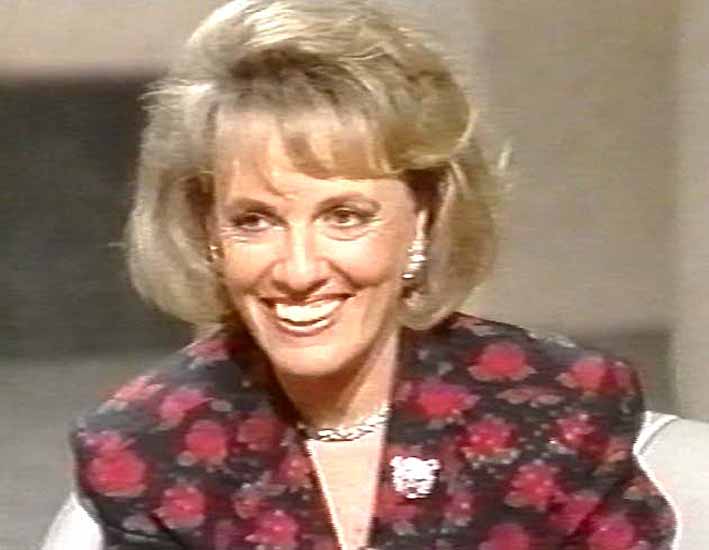
Television presenter Esther Rantzen's code name was 'Queen'
But how does a potential subject reach the stage of being given a codename in the first place?
Malcolm Morris, John Graham and I get together towards the end of June/beginning of July. The production team members are still away. The majority being freelance, they will be picking up other work if they can find it, or need it. Some will not have been able to shake off the travel bug – even at their own expense.
Over lunch at a local wine bar, Malcolm, John and I plot how the team will spend their autumn and winter, what the Life assignments will be. We have a minimum of twenty-six shows to put together, and we start recording in September. As well as picking our subjects, we have to decide where we'll shoot – we have a Granada studio booked, so we need at least four subjects we can catch in and around Manchester. And we'll be going back to LA, and possibly to Australia, so we need several stars in each of those places.
What are we looking for? Well, This Is Your Life is the biggest and best surprise party ever devised, so it could be useful if the potential subject had something to celebrate – a moment of triumph among his or her peers. Personally, I love newly crowned world champions, at anything.
But someone out there might be a totally unsung world champion – simply and selflessly giving the best of themselves in the interests of others less fortunate.
Seeking the right 'mix' of subjects for the twenty-six-week season is the head-banging part of the job. We must try to please all of the people all of the time.
'Why don't you do more stars?' ask some letters. 'Why don't you do more real people who help others?' plead others. Some demand more sports people, others more from theatre and the arts.
In the weeks leading up to this meeting, possible subjects in a wide variety of categories will have been going through our minds; now, Malcolm, Johnny and I talk through our ideas and make a shortlist.
This is all very well, but it cannot, at this juncture, take into account the availability of a certain subject on a certain date, nor the availability of all those people whose contributions could make or break a Life story.
Nor do we shy away from the possibility of certain subjects telling Michael where to go and what to do with his Big Red Book.
So, at our pre-season meetings, optimism is the watchword. Without it, Life would be dead.
Having agreed our mix of programmes for the first five of the series, we write codenames in the allocated squares on the blackboard. The next twenty-one will be added as soon as possible. At this stage it is known as the 'Dream Board' – because actually achieving these recordings on the hoped-for dates is still far removed from reality.
Reality re-enters Room 226 in the middle of July, with the arrival back of the research team, plus the programme's director Brian Klein (a former Life researcher) and his PA Irene Clark, still bubbling with enthusiasm after years on the Life.
Professional collectors of other people's anecdotes for use on the programme, the team go on for some time swapping what-happened-to-you'll-never-guess stories of their own. Then it's down to business.
Each researcher is assigned a potential subject to look into. Each will provide, within a few days, a feasibility report, known to all as a 'feeza'. These early reports are not merely potted biographies, they will include points against as well as for going further on a given subject. They will also give a possible 'spotlist' of people likely to appear on the programme.
Occasionally, the 'feeza' will sound early warning bells against going with a Life. There may be too many skeletons in the cupboard. But this is rare. After all, we are not an investigative programme. The Life is a party. If we can avoid it, there will be no unwelcome guests.
While the 'feezas' are being prepared for the new series, Michael Aspel is taking a well-earned break, not only from the Life but from his live chat show. His keen interest and contribution come at a later date, when we know where we are at and with whom.
The researchers talk through their 'feezas' and everything is looking possible, including a Life on the rock band Status Quo, celebrating their twenty-five years in the business with a tour called 'Rock 'Til You Drop'. Unfortunately, after several weeks, we will have to drop them. Various key people turn out to be unavailable and we agree with the band's management that the show will be scrapped. Perhaps we can resume negotiations at a later date.
What happens next is this. Someone very close to our potential subject is contacted by telephone. This could be wife, husband, parent, brother, sister, business partner, closest friend, manager or agent. The conversation usually begins like this: 'Good morning. My name is... and I work on the This Is Your Life programme. I would ask you, please, to treat this call in the strictest confidence...'
Things can go wrong even at this early stage. We once planned a Life on gravel-voiced American actress Elaine Stritch who, at the time, was living at the Savoy. A researcher telephoned her suite. When a deep American voice boomed out the number of the suite the researcher thought it was Elaine's husband.
'Good morning. We're thinking of doing a This Is Your Life on your wife, what do you think?'
Came the reply: 'Great idea, baby, but this is Elaine Stritch...'
No such bad luck this particular morning as our researchers make their first approach calls.
One of our most experienced researchers, Sue Green, has produced a 'feeza' on heart-throb actor Nigel Havers, who charmed millions as The Charmer. Her first call is to Nigel's wife, Polly, a former model. They arrange to meet for a strictly confidential lunch. She is on delicate territory because Nigel's divorce from his first wife hit the headlines.
During lunch, Polly advises Sue to contact Nigel's agent and production company business partner, Michael Whitehall. They have an exciting new project in the pipeline called Good Guys, co-starring Keith Barron, with a host of big name guest stars.
Nigel's parents, too, must be contacted before they leave for a holiday in the South of France. Lord Havers was a former Attorney-General, and very much in the public eye. Again a delicate situation. He may not wish for the kind of TV exposure This Is Your Life gives.
Sue Green is greatly relieved when Lady Havers turns out to be cheerfully co-operative. Sue told me, 'When Lady Havers said, "Sue, just call me Carol," I knew we were going to be all right. She is such a sweet lady.'
Sue is well into the research when she takes a call from the south of France. Lord and Lady Havers are having second thoughts. Sue arrives at a compromise. Director Brian Klein will make sure the cameras do not linger on them, nor do they have to speak, so minimising any attention they will receive. Sue puts down the phone and stares into space. 'Phew' is all she can manage.
The next stage is the researchers starting to type up their findings, from newspaper cuttings, books, interviews with relatives and friends. Who haven't our subjects seen for a long time, but would genuinely love to see again? Answers range from school teachers who first inspired them to old pals from the Services. Two teacher brothers at his prep school first fired Nigel Havers's acting ambitions.
Michael Whitehall can get Nigel to a preview of the first episode of Good Guys at nearby Twickenham Studios. Keith Barron will be there, and so will Martin Jarvis, Angela Thorne, Hilary Gish and former Eastenders star Leslie Grantham. An unexpected guest will be Michael Aspel.
We are now up and running. Changing my 'programme consultant' hat for my 'writer' hat, I am bombarded with research on half a dozen programmes.
Other researchers have followed the same pattern as Sue Green. They, too, have been seeking the vital piece of information which will give us the best impact start to the programmes. The pick-up is all-important to the Life.

Television chef Keith Floyd was surprised in a Dublin pub in August 1991
First information on broadcasting chef Keith Floyd is not what we wanted on our menu. It seems he will not be at his Devon pub where we hoped to surprise him with Michael Aspel popping in for a pint. Instead, Keith will be in Dublin. The wheels are set in motion for the pick-up team, with Michael, to be in Dublin on the same day, surprise Keith and fly him back to our studios here at Teddington. His codename is 'Soup', but it looked for a while as though we could be in it. We finally track him down in Dublin – to a pub, and Michael pops in for a pint.
Pam Ferris (codename 'Wheel'), Ma Larkin in television's hit of the season The Darling Buds of May, will be filming a new series for Yorkshire Television in Leeds. They are happy to go along with our plan to have Pa Larkin, David Jason, announce an unexpected visitor to the farmhouse, and for Michael to walk into the kitchen where Ma is chatting to her screen daughter, the stunning Catherine Zeta Jones. I have no shortage of male helpers when I brief Catherine on her script at our hideaway hotel.
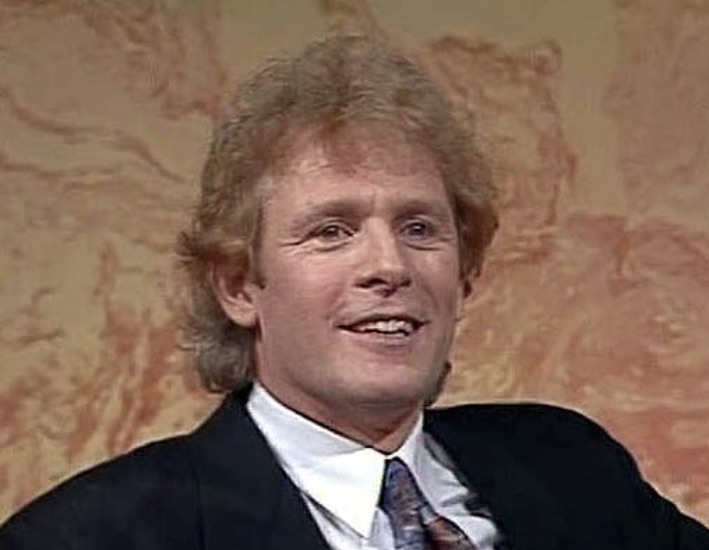
Paul Nicholas was surprised during the curtain call of the musical Barnum at the Bristol Hippodrome
Next, we have the go-ahead for a spectacular pick-up for Paul Nicholas (codename 'Saint') at the curtain-call at the Bristol Hippodrome, where he is starring in the musical Barnum. John Graham gets on to the studios of HTV in Bristol so we can take Paul straight there.
We will be recording a whole batch of programmes out of Granada's Manchester studios, including Coronation Street's own Thelma Barlow ('Till'). We will be taking special care of the Big Red Book this time.
When we went to the Street to surprise its longest-serving star Bill Roache, who plays Ken Barlow, the book went walkabout. We had Eamonn Andrews dressed as an Arab (Bill is a former Captain in the Royal Welsh Fusiliers and served with the Bedouins) complete with camel. Had the camel eaten the book?
It was nowhere to be found. Malcolm Morris grabbed a red plastic folder and shoved it into Eamonn's hands just as Bill came round the corner. He didn't notice the difference, and nor did fifteen million viewers. Oh, and the camel wasn't guilty. Someone had picked up the book out of curiosity and left it behind the bar of the Rover's Return. It was returned to us in the nick of time for the actual show.
We also get the go-ahead to pick up danger man comedian Bernard Manning in full flight at his own nightclub. Fingers on the 'bleep' machine for that one.
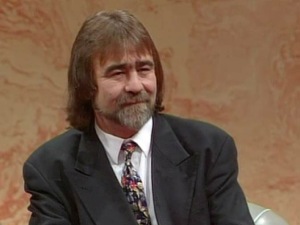
Award-winning television writer Alan Bleasdale in February 1992
Award-winning television writer Alan Bleasdale (GBH, Boys from the Black Stuff) we aim to surprise in his native Liverpool, then we are off to Dundee, to visit Caird Hall, to tell the story of that wisp of a world champion, 10000 metres winner in Tokyo and winner of the New York Marathon, Liz McColgan ('Line').
In stark contrast, researcher Sarah Cockcroft is working on one of Life's unsung heroes – Oxfam's globetrotting trouble-shooter Jim Howard, who has saved millions of lives in third-world countries and in the aftermath of the 'Killing Fields' of Cambodia.
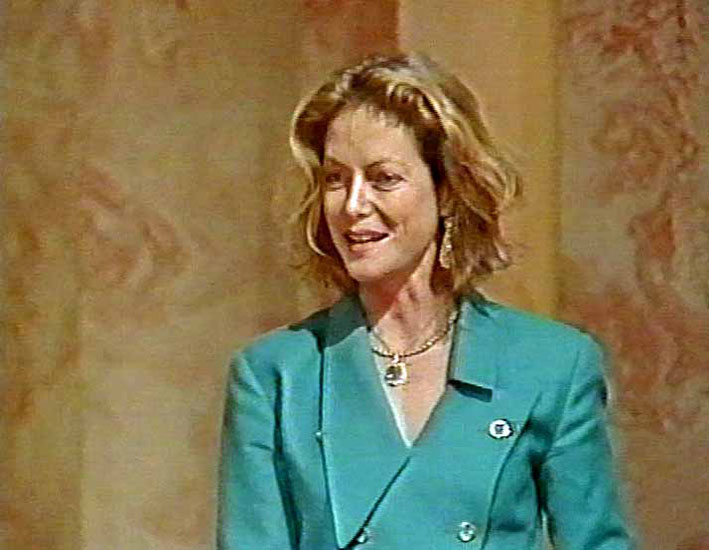
Actress Jenny Seagrove brought her dog, Tasha, on the Nigel Havers Life
A bit of light relief comes from Sue Green, who has been talking to actress Jenny Seagrove about coming on the Nigel Havers Life. She played his wife in Hold The Dream. Said Sue: 'Jenny would like her dog, Tasha, to be on the show.'
She knows the reaction this will get from Malcolm. 'No, no,' he grimaces. 'You know what they always do...'
I talk him round when I suggest a gimmick entrance. Instead of giving Jenny the voice offstage, we give it to the dog. On the show, after a clip of Hold The Dream Michael says, 'A glamorous star with you there. You may recognise this voice, too...' And I scripted:
TASHA (THE DOG) V/O
'WHOOF, WHOOF, WHOOF...'
It took a while to get the perfect recording, but Jenny was happy, and so was Tasha. And very well behaved, too, much to Malcolm's relief, if that's the right word.
While all this has been going on, film researcher Sue Tiplady will have been busy seeking and getting clips which may be appropriate to our projected programmes. When she is confident she has got just about everything I may need to put in my script, she will say, 'Come one, Roy, we're going to the pictures', and we sit down in front of a TV screen by the big table to play the clips. I make my selection and, if necessary, write Michael a brief commentary to speak over the chosen film. We also make a note of all the 'out' lines: these will go in Michael's script, so he will know when each clip is finished.
Another important visual contribution to any Life is the still photographs. Researchers will have been going through many a family album tracing the pictorial history of our subjects. Nothing gets a giggle more than a baby snap.
So, with briefcase bulging with research notes and copies of family pictures, I head for the peace and quiet of my office at home. In fact the telephone never stops because the nature of the programme means you are working on quicksands. So-and-so has had to drop out of one show, someone else finds he or she can now make it at the last minute, and it all has to be scripted.
Dean Martin has decided he will film for us in Las Vegas for Engelbert Humperdinck. But only if I write something for him. I write in the manner of Dean's drunk act. The tag is that he just cannot get his tongue around the name. He takes a slurp from his glass and mutters darkly, 'You'll just have to change that name, boy.' It gets a big laugh from Engelbert on the show.
The first batch of scripts completed, a car takes them to Michael's Surrey home for him to read and add his own comments. As he and I are about the same age, and share a similar background and sense of humour, his changes tend to be minimal. He likes to contribute especially to the fun bits of the show.
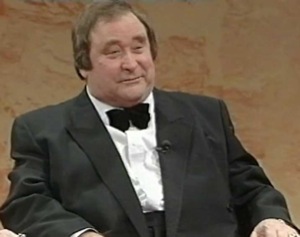
Comedian Bernard Manning was surprised in Manchester in November 1991
How he stopped himself from 'corpsing' – laughing uncontrollably – during the Bernard Manning show I'll never know. It was laughs all the way. Comedians Jim Bowen and Dougie Brown just 'went', especially when Bernard's former sergeant major appeared. He was unintentionally funny, talking on and on about Bernard's army days – Bernard had accidentally bayoneted him – so that big Bernard could not get a word in. This was a novel experience for him, but eventually he looked at his watch and said, 'Have you finished? I'm going on holiday in June.'
When the scripts return from Michael's scrutiny, director Brian Klein then gets to work 'putting the cameras on' – noting which of the six studio cameras will take what shots and from which angles of the action on stage. One camera – known as a 'slave' – will remain on the subject throughout, so not a single reaction is missed.
These are the scripts everyone will work from on the day of the show.
That day begins with a script conference round the table with Michael Aspel. I sit to his right and Malcolm to his left. On my right is the script secretary, ready to make any last minute changes. Brian Klein and his PA will be in the studio control room lining up his shots with the cameramen.
Also at our meeting are associate producer John Graham, the researcher responsible for that day's programme, and the floor manager, who has charge of everything that happens on the studio floor. This includes timing Michael's cues in and out of film inserts, and leads-in to the offstage voices.
We will now have been joined by a second director and a PA who will film the pick-up. John Graham will be familiar with the location, and he and the unit director will talk Michael through every step. There is no room for error. Missing the pick-up would be like missing the finishing post at the Derby. We have only one shot at it, and it's got to count.
For the pick-up today, Michael is off to Twickenham Studios from where he hopes to bring back Nigel Havers. There has already been a hiccup. Nigel wanted to change the date of the screening of Good Guys. His partner told him this could not be done. But he didn't tell him why.
Before he changes from casual gear to smart suit, Michael 'walks through' a rehearsal, purely for his moves and cues into film, and for cameras. Everybody in the team not working on the next show stands in for the real guests who will fill the seats on the night.
We break for lunch in the huge Thames riverside dining room where the after-the-show party will be held. Usually, over lunch, unless there are any pressing problems outstanding, we try to avoid in-depth discussion about that night's programme. The attitude is that if we are not fully prepared now we never will be.
We have plenty of other things to talk about. We are all film and television addicts, including Michael – he has been a movie buff since childhood, which seems to have been spent at the Granada, Tooting.
If it's not films, it's cars. Michael takes some gentle ribbing because of his penchant for seemingly changing his car every few weeks. In recent months he has had a Jaguar, an Alfa Romeo, a Jensen and now a restored Mercedes.
He leaves in a studio car for the pick-up, with Malcolm Morris and John Graham.
For the next two rehearsals, one without, the final one with guests, I stand in for Michael, holding the Big Red Book, going through the whole programme. Brian Klein perfects his shots, and when the guests arrive to record their voices off and go through their entrances and exits, I discuss with them and the researcher any problems they may have in telling their particular contribution to the programme. It still surprises me how often show-business professionals are nervous under these circumstances.
While the guests go to make-up and to their dressing rooms to get changed, we wait in Room 226 for the call from the car-phone from John Graham that will tell us if we have a show or not. It's the nail-biting period of the day.
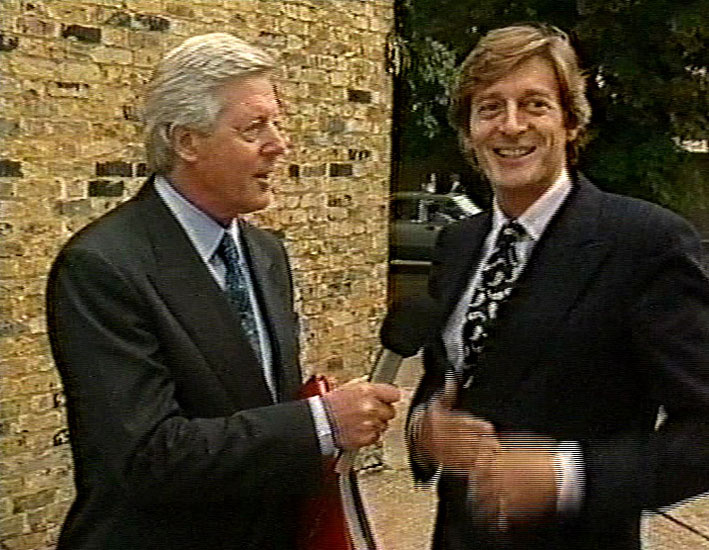
Actor Nigel Havers was surprised by Michael Aspel at Twickenham Film Studios in September 1991
The phone rings. It's Johnny: 'We're on! Heading back now!'
In the Green Room the good news is relayed to the guests, who resume sipping their drinks without any anxiety. The guest of honour is led to a luxury, film-star-type trailer in the scene dock, so that there is no chance of him or her spotting any straying guests. Champagne is poured purely for purposes of relaxation.
In the studio control room Brian Klein calls, 'Quiet, please, everybody. And cue pick-up VT...'
Then the moment of the pick-up is shown to the studio audience and to the guests on the programme. It is watched on a behind-the-scenes monitor screen by Michael and the subject.
The famous signature tune strikes up, the floor manager cues Michael, and, as the script states: 'Subject enters with Michael, greets, and sits.'
Another Life is underway. In half an hour subject, Michael and ourselves will be celebrating at the party Thames always throw. The buffet is five-star, and guests can have the drink of their choice. A fleet of cars stands by to take them home. But that won't be until late... very late.
If this all sounds very extravagant, remember that no one gets paid for appearing on the Life, so the hospitality is one way of showing our appreciation. Even so, each show costs less to produce that the average sit-com.
Next day there are thank you letters to be written, and photographs taken during the recording to be chosen and put in the Big Red Book, which is still in our possession. It will be sent, complete with a photographic record inside of the programme's big moments, and a cassette recording of the programme.
Then it's our turn to receive the thanks. 'Astonished', 'Still in a daze', 'So thrilled', 'The night of my life', are just some of the comments.
It really does make Life worthwhile.